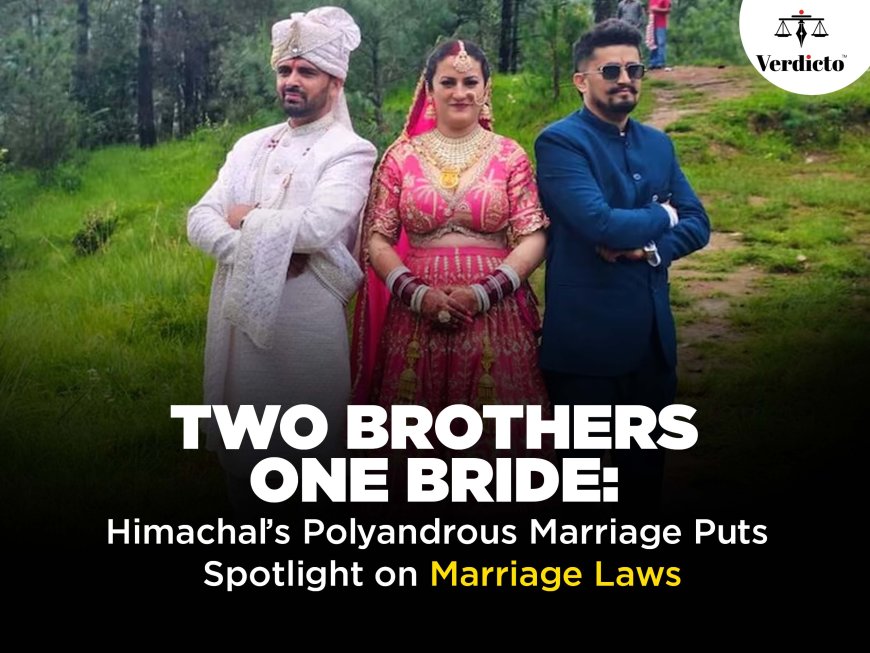Two Brothers, One Bride: Himachal’s Polyandrous Marriage Puts Spotlight on Marriage Laws
Is polyandry legal in India? Explore the Hatti tribe’s customs, Scheduled Tribe exemptions, and landmark Supreme Court judgments.

Recently, two brothers from Himachal Pradesh’s Hatti tribe, named Pradeep and Kapil Negi, married the same woman, Sunita Chauhan of Kunhat village, by a culturally important polyandrous ceremony. The three-day event was held in Shillai village of Sirmaur district and saw hundreds of villagers participate along with performances of folk songs, traditional dances, and local rituals, which raise the burning question related to the legality of polyandry in India.
Meaning of Polyandry
Polyandry in India refers to the practice of polyandry, whereby a woman has two or more husbands at the same time, either historically on the Indian subcontinent or currently in the country of India. An early example can be found in the Hindu epic Mahabharata, in which Draupadi, daughter of the king of Panchala, is married to five brothers.
In case of Himachal Pradesh, polyandry once thrived in the remote hill regions as a practical means to preserve undivided ancestral land and maintain joint family harmony. Today, it quietly persists within the Hatti community, where age-old traditions remain intertwined with the realities of survival.
Legal Status of Polyandry
Section 2(2): Exception for Scheduled Tribes (STs) “Nothing contained in this Act shall apply to the members of any Scheduled Tribe unless the Central Government, by notification in the Official Gazette, otherwise directs.”
This means that the act does not automatically apply to members of Scheduled Tribes (STs). Its applicability to STs requires a special notification from the Central Government published in the Official Gazette. In the absence of such notification, tribal communities continue to be governed by their customary laws.
As Section 3(a) in Hindu Marriage Act defines "custom" as , "A rule which, having been continuously and uniformly observed for a long time, has obtained the force of law among Hindus in any local area, tribe, community, group or family: Provided that the rule is certain and not unreasonable or opposed to public policy."This means that custom must be ancient, uniformly followed, and certain.It must be reasonable and not against public policy.It should have legal recognition within the concerned group.
Bigamy (having more than one spouse at the same time) is prohibited.
A second marriage while the first is subsisting is void under Section 24, and criminally punishable.
Bigamy is criminalized under Section 81. Punishment includes up to 7 years of imprisonment and fine.
In India, marriage laws are personal and differ for Hindus, Muslims, Christians, etc.
But Scheduled Tribes (STs) are excluded from the automatic application of the Hindu Marriage Act (Section 2(2)) unless the Central Government issues a notification.
STs and Constitutional Protection
Article 342: Identifies Scheduled Tribes.
Fifth Schedule: Provides special governance and protection for STs in certain areas (especially tribal-dominated states).
Part XXI: Permits differential treatment to preserve STs’ customs and traditions.
This constitutional framework acknowledges the cultural autonomy of STs, including practices like polygamy or polyandry, so long as they are customary and not illegal under general law.
As per Section 2 of the Uttarakhand UCC Rules, 2025, the Code exempts members of Scheduled Tribes (as defined under Article 366(25) read with Article 342), and those whose customary rights are protected under Part XXI of the Constitution.
The polyandrous wedding in Himachal’s Sirmaur district highlights the complex intersection of tradition, law, and cultural identity in India. While polyandry is prohibited under the Hindu Marriage Act, the Special Marriage Act, and the Bharatiya Nyaya Sanhita, the constitutional protection granted to Scheduled Tribes allows such age-old customs to survive in pockets like the Hatti community. This delicate balance between modern legal frameworks and ancestral traditions underscores the ongoing dialogue between law and culture, raising critical questions about how far the state should intervene in preserving or regulating tribal practices in contemporary India.
Verdicto will continue to follow this story closely, bringing you legal insights, expert interviews, and fact-based analysis.
Stay tuned. Because where law meets journalism — truth must prevail.
📌 Follow us on YouTube, Instagram, and Twitter for more updates.







